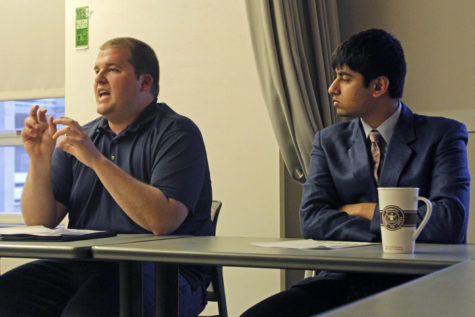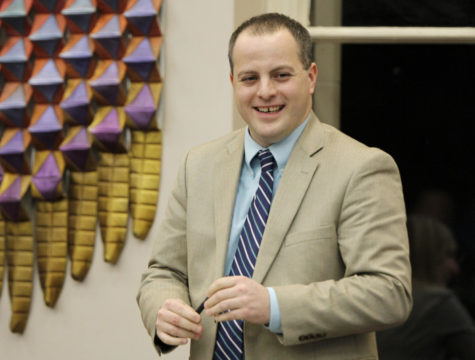Don’t fence me in
November 16, 2007
Recent fencing on the ISU campus has been a source of contention for students and faculty, while campus planners say it’s necessary to keep the campus beautiful.
“There really is no plan, we evaluate the conditions of the grounds and the turf’s ability to respond to the traffic patterns,” said Catherine Brown, campus planner for facilities planning and management.
Then, she said, they install the post and chain fences in response to where the ground is marred by excessive traffic.
“We generally don’t put them in and pull them out, they are usually installed and end up being there for a while,” Brown said.
Ashley Rosener, freshman in English and founder of a Facebook group that opposes the new fencing, which currently has 1,195 members, said she thought starting a Facebook group would be a good way to get her opinion out.
“I have enjoyed reading all of the comments from both sides of this issue and believe there are numerous points supporting the removal of at least some of the newly erected fences,” Rosener said.
She said she has been privy to several ideas and her Facebook group had generated a lot of them.
“First, bushes could be planted in place of where some of the fences are,” Rosener said. “I know this is costly, but I think the reputation of ISU’s beautiful campus makes the cost a wise investment.”
Brown said the post and chain fencing has not been the only way her department has tried to redirect traffic patterns.
“Part of the challenge is the repetitive pattern right over the same area,” Brown said. “On some occasions we’ll till up the damaged area and re-seed it.”
She said they also put up “plantings” or “natural barriers” and they have both permanent or temporary fencing.
“There has been added pressure from pedestrians who have been cutting across and cutting paths and other things and we’ve been trying to address how to protect the turf in the winter,” Brown said.
She said the fencing is to help keep the campus attractive. There are also temporary snow fences the department sometimes utilizes during the winter when the grass can’t grow sufficiently to keep up with traffic.
Rosener said the paths worn by pedestrians could be tilled and re-seeded and then signs could be posted requesting that people stay off of the grass.
“The cow paths could be left alone as tokens from ISU’s past,” Rosener said. “People have been using these paths for years and they are a part of ISU’s history, an important thought considering the celebration of ISU’s 150th year in operation.”
Brown said erecting the fences around campus was not something she wanted to do.
“My preference would be that we not have any post and chain fences around campus, that there would be a respect and an appreciation for the grounds and the beauty of campus,” Brown said.
She said she is happy to hear that people are responding to the addition of fencing on campus.
“In one sense I’m pleased that people care enough to say that they don’t consider the fences attractive because that’s a message to me that they do value the campus environment,” Brown said.
Brown said her department welcomes discussion about the fencing and they’ve offered to talk with the student leadership.
Elizabeth Suess, freshman in meteorology and a member of the Facebook group, said one of the problems she has with the fences is that they block off a path she uses regularly.
“I have a rather long walk from Carver to Kildee after my math class,” Suess wrote in an e-mail. “The path that I usually take (which is cutting across Central Campus) to get to the sidewalk on the east side of Catt Hall has been blocked off.”
She wrote that she doesn’t have enough time to follow the sidewalks if she wants to be able to get to class on time.
Rosener said she loves the way that the campus looks.
“The landscaping is wonderful and it’s one of ISU’s greatest assets,” Rosener said. “That said, the fences detract greatly from the aesthetics of the campus. The stark steel fences are tacky and a hindrance to some of the breathtaking views on campus.”
Ian Ringgenberg, senior in anthropology and GSB director of student affairs, said the fences cost about $10 per foot to construct.
“Landscaping is normally used where it is possible,” Ringgenberg wrote in an e-mail.
He wrote, however, that sometimes it isn’t possible to use landscaping in areas where shade from the trees wouldn’t allow growth.
“I’m guilty myself [of] cutting across campus, but we have to realize that there are too many people on this campus for us all to be able to do that,” Ringgenberg wrote.
He thought the fencing was “an issue of balance.”
“There are places where fencing protects landscaping and prevents the destruction of very beautiful parts of campus,” he wrote. “We need fencing to help re-grow grass in areas that have been severely trampled.”
He wrote that the fencing shouldn’t be allowed to ruin recreation areas, however.
He wrote that he is currently working with facilities planning and management on the issue.
“I would encourage any students concerned about the issue to either contact me by e-mail or contact their GSB senator to recommend some specific changes that they would like to see,” Ringgenberg wrote.









